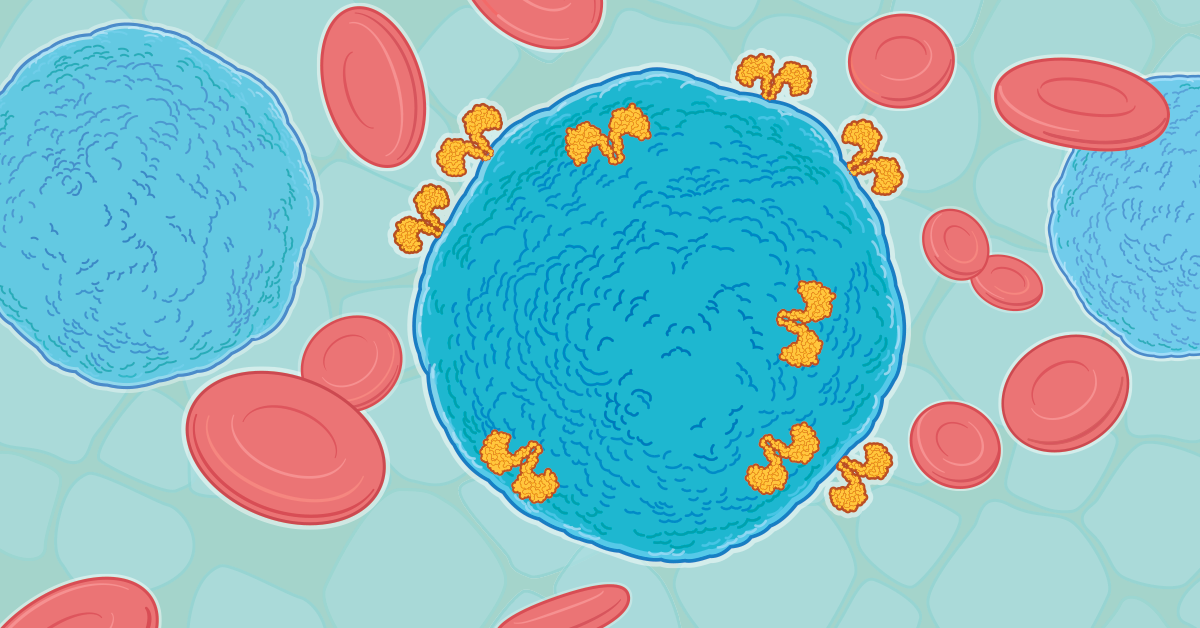
CAR T-Cell Therapy 101—Your Questions Answered
-
Q. What is Chimeric Antigen Receptor (CAR) T-cell Therapy?
A. CAR T-cell therapy is just one kind of immunotherapy. In CAR T-cell therapy, immune cells known as T cells are extracted from a patient’s blood. They are then genetically altered to recognize and bind to cancer cells, multiplied, and infused back into the patient. The newly created CAR T cells are now equipped to find and destroy cancer cells.
BONUS FACT: T cells are altered in the lab in a way that adds the right receptor protein on their surface so that they can recognize a cancer cell and bind to it. The immune system can then recognize, attack, and destroy the cancer cell.
Q. Why can’t the body’s T cells find and destroy cancer cells without being modified?
A. T cells are a type of white blood cell that search out and destroy bacteria, viruses, and other invaders that the immune system does not recognize. Because cancer cells are the body’s own cells that grow and divide out of control, T cells may not recognize them as foreign.
Q. What cancers are being treated with CAR T-cell therapy?
A. CAR T-cell therapy is FDA-approved for adult B-cell non-Hodgkin lymphoma, and pediatric and adolescent acute lymphoblastic leukemia in patients who did not respond to standard treatment or relapsed after two other kinds of therapy failed. CAR T-cell therapy is the only FDA-approved therapy known to provide a substantial benefit to these patients.
“At Fox Chase, we’re excited to offer a new standard of care with Yescarta®—an FDA-approved commercially available treatment for lymphoma patients,” said Dr. Henry C.H. Fung, director of the Fox Chase-Temple University Hospital Bone Marrow Transplant Program. “In addition, we continue to offer multiple other cellular therapies for our patients through clinical trials.”
Q. What happens when a patient comes in to get CAR T-cell therapy?
A. Blood is drawn from the patient and T cells are extracted. The T cells are then sent to a specialized lab where scientists genetically modify them to recognize cancer cells. The newly altered T cells are multiplied in the lab and sent back to the hospital. As this process is occurring, patients receive chemotherapy to prepare them for the infusion.
“Patients receive a weak form of chemotherapy to prepare the body to accept the CAR T-cell treatment and ensure the body doesn’t reject it,” Fung said.
These modified T cells are infused back into the patient so that they can now find and destroy cancer cells.
Q. How long does the CAR T-cell therapy take?
A. It typically takes anywhere from a few days to a few weeks, from T cell harvest to infusion of CAR T cells. CAR T cells typically reach peak levels about 1 to 2 weeks after infusion.
Q. What are the possible side effects?
A. Cytokine release syndrome, also known as a cytokine storm, is the most common side effect. This is the body mounting an immune response. The storm can be visualized as T cells multiplying and attacking cancer cells. Patients say it feels similar to a severe case of the flu. Intravenous fluids and acetaminophen can alleviate some of the symptoms.
CAR T cell related encephalopathy syndrome is another known side effect. It generally begins about five days after the infusion and lasts two to four days. Some patients have neurologic symptoms like confusion, disorientation, or an inability to speak, but the symptoms are reversible.
Q. How can patients obtain CAR T-cell therapy?
A. FDA-approved products are available for adults with B-cell non-Hodgkin lymphoma and children with acute lymphoblastic leukemia who have had two unsuccessful treatments. For other cancers, CAR T-cell therapy may be available through clinical trials, like the ones open at Fox Chase.
Q. Why is CAR T-cell therapy so exciting?
A. This is the first time a patient’s own immune cells have been programmed to recognize and attack cancer cells. CAR T-cell therapy is being used in certain cancers for patients who have few good options to provide a chance for durable remission.
“CAR T-cell therapy is exciting because it marks a breakthrough innovation in cancer care,” Fung said. “This therapy has the potential to offer a clinical option in patients for whom all other treatments have been exhausted.” Fung continued, “We can now offer these patients hope they wouldn’t have had before.”
Q. Why is CAR T-cell therapy called precision medicine?
A. Damage to a cell’s DNA may allow it to grow uncontrolled, eventually forming a cancerous tumor. Tumor growth in each patient is believed to be fueled by unique mutations. Precision medicine attacks all tumors with these specific mutations, regardless of where they are in the body.
Q. What is the future for CAR T-cell therapy?
A. Clinical trials around the world are evaluating CAR T-cell therapy in many different types of cancer, including multiple myeloma, acute myeloid leukemia, and B-cell lymphomas. Research is also underway to make CAR T-cell therapy safer and more effective.
To find out more about CAR T-cell therapy at Fox Chase, visit FoxChase.org/CAR-T.
